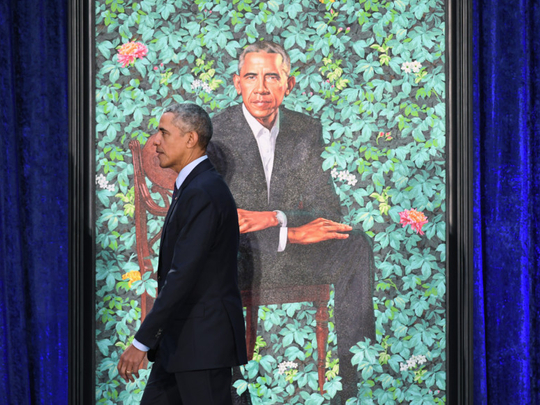
Kehinde Wiley’s spectacular new portrait of former US president Barack Obama speaks to the resolute seriousness of the former president, and at the same time, it radiates a sparkling freshness. How exactly can one picture accomplish that? By dividing it into two complementary parts, both of which are deeply grounded in art history, including a significant nod to one of Obama’s predecessors.
From top to bottom and side to side, the entire field of the picture is filled with a lush garden. Blue lilies from Africa, jasmine flowers from Hawaii, and good old American chrysanthemums erupt from a rising field of ivy so bountiful that its leaves begin to overtake the armchair on which Obama sits. They make inroads on his jacket, trousers and shoes. In a few hours, he may disappear altogether.
Rich garden settings are rare for portraits of men of importance, mostly because the overwhelming imperative is the projection of respectability or significance. Gainsborough, the Pre-Raphaelites and others gravitated to dense floral fields, however. And the garden itself has had special importance for painters, dating from the Roman Villa of Livia in the first century BC. There, oak, quince, pomegranate, strawberry, ivy, roses and other plants impossibly thrive at the same time.
Obama is inextricably embedded in nature: not located on the firm ground, but floating on an Arcadian cloud of plants that do not actually grow in the same places. To be sure, the different plants speak to his different points of origin: Kenya, the Pacific, the Midwest. But it also reflects his embrace of the diversity of the world, all flourishing in the spaces about him. We might, one day, look back wistfully at Wiley’s image as a time before the acrimony and disunion that mark our current political stage. Of course, it was not all roses during the Obama administration, but the point of a presidential portrait is to set the terms for remembering and honouring.
The other half of Wiley’s portrait shows a serious man sitting on the edge of a carved armchair, arms crossed, looking directly ahead, wearing a suit with an open-collar shirt. Wiley, beyond his skill as a portraitist, is a fabulous student of art history. It comes as a surprise — or perhaps no surprise — that his portrait of Obama is a riff on George P. A. Healy’s portrait of Abraham Lincoln. There, Healy, like Wiley, set the president in a space without distractions and did not include the usual cast of props that mark official portraits of men: desks, papers, columns, etc. Healy’s portrait usually hangs in the State Dining Room of the White House and can be seen almost daily in news photographs as the backdrop to large presidential gatherings.
The original picture from which Healy extracted the portrait of Lincoln alone was a group portrait that he titled The Peacemakers. It showed Lincoln conferring with Admiral David Dixon Porter and General William Tecumseh, General Sherman and General Ulysses Grant on board the steamboat River Queen on March 28, 1865. The meeting strategised ways to close out the Civil War; the Appomattox Campaign began the next day. You can see Healy’s group portrait behind Obama and Representative Nancy Pelosi, Democrat in a photograph from 2009.
Wiley’s portrait of Obama, appropriately unveiled on Lincoln’s birthday, channels the Healy painting, especially the old-style chair, the simple setting, the alert pose and thoughtful expression. Wiley’s Obama, however, is not lost in thought like Healy’s Lincoln, but instead looks outward and leans slightly forward, as if waiting for your next word. And instead of the darkness that threatens to engulf Lincoln, Wiley substituted an effusion of plants.
The artist is not just channelling Healy, he’s linking the Obama presidency to Lincoln’s — painting Obama as the rich fulfilment of the promise of Lincoln’s abolition of slavery. Many presidential portraits refer to an earlier holder of that office: George W. Bush’s portrait in the White House, for example, follows a template established by Gilbert Stuart’s majestic Lansdowne Washington, painted in the 1790s. But until now, few presidential portraitists have invoked the Lincoln model.
We have known since October that Wiley was to paint the Obama portrait, which gave me months to speculate on what he might paint, and what I thought I would paint if only I were an artist. Over the past four months, I had imagined a painting in which he would be on a basketball court, perhaps sitting with that look of gravitas, but definitely spinning a ball on one finger. Now, I can defer to Wiley’s well-earned insight; I had never previously associated Obama with gardens but was pleasantly surprised to see Wiley’s brilliant concept. Should Obama have been holding a Spaulding with those long hands, it would have been perfection. But a nod to Abraham Lincoln is a better thing to do.
— Washington Post
Paul Staiti is author of Of Arms and Artists: The American Revolution through Painters’ Eyes. He teaches at Mount Holyoke.








